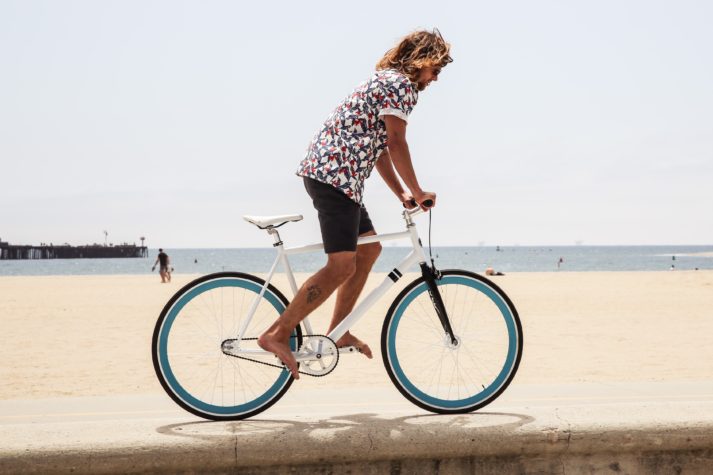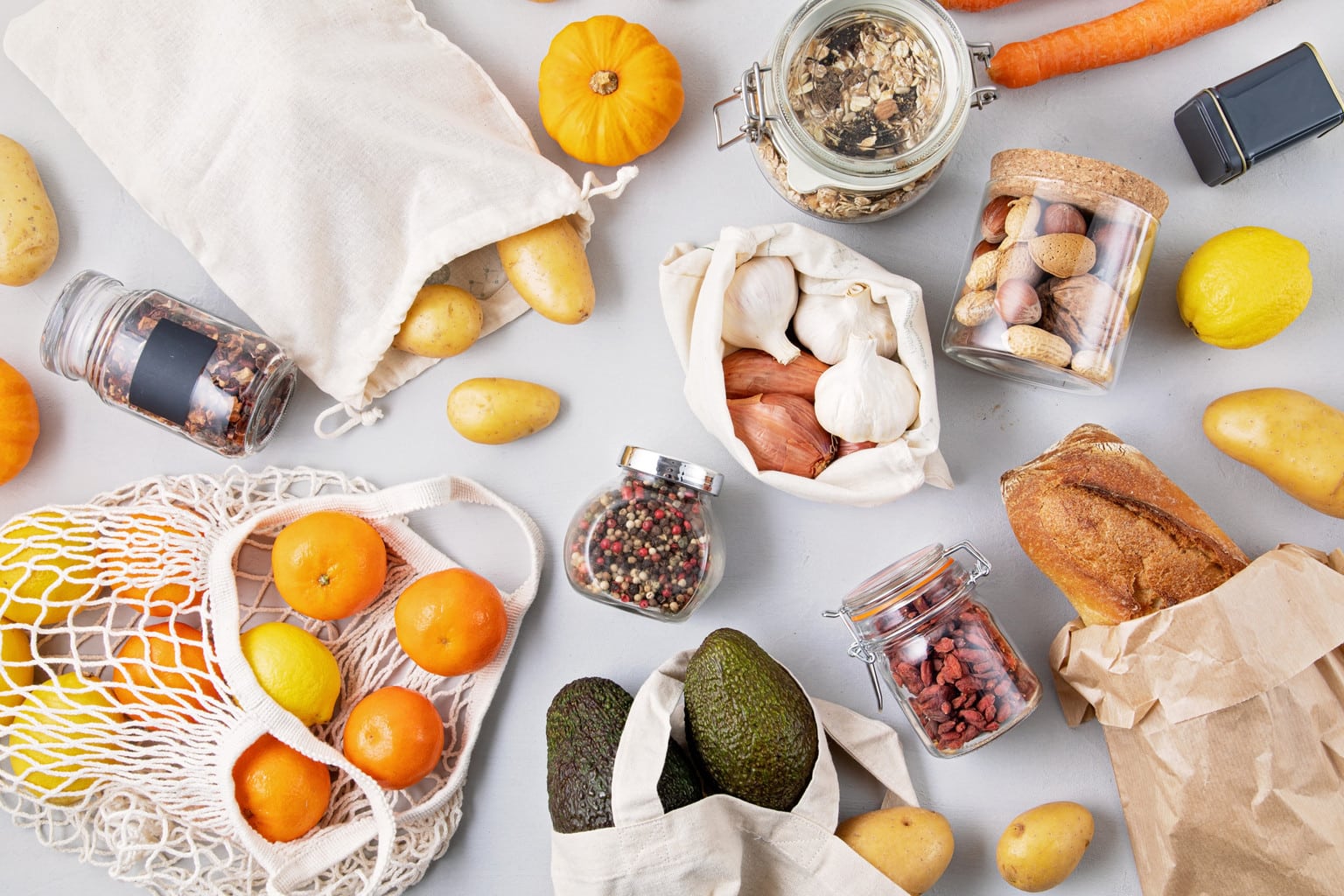Being more eco-friendly has a lot of perks, and not only to the planet. You can save money when going green, simply by living your life with the environment in mind.
Saving money and going green go hand-in-hand, that I often wonder why more people don’t transition to more sustainable solutions. There’s a lot of perks!
The littlest changes can have a big impact, especially when more people implement these changes into their day-to-day.
And since going green saves money, why wouldn’t you want to live a more eco lifestyle?
This post contains affiliate links which means I may receive a commission at no extra cost to you should you click through and make a purchase.

Here are some of the best ways to save money when going green.
1. Reduce Food Waste
If you’re trying to be more eco-friendly on a budget, aim to reduce your food waste.
Growing and distributing food requires resources, and when we waste food we’re wasting those resources as well as the money we spent to buy it.
By watching our food and ensuring it gets eaten, it helps save our hard-earned dollars and helps the environment at the same time.
Check out my post with a bunch of tips to help you reduce food waste at home.
2. Make Stock From Food Scraps
A zero-waste tip for saving money is by reusing your vegetable peelings and meat bones to make stock instead of throwing them away or composting them.
Save your vegetable peelings and beef/chicken bones to make a homemade stock which will eliminate the need to buy stock from the grocery store.
3. Regrow Vegetables From Scraps
Self-sufficiency is super important when it comes to being more green. Especially these days where a lot of produce still comes wrapped in plastic, regrowing your own vegetables will help you reduce waste and save so much money.
Regrowing vegetables from scraps is as simple as putting the veggie scrap in water until roots start forming, and then transplanting to a pot with soil. Change the water daily for quicker results.
Vegetables you can regrow from scraps:
- Celery
- Green onions
- Potatoes & sweet potatoes
- Cabbage & lettuce
- Carrot tops
Here are more foods you can regrow from scraps.
4. Grow a Garden

Regrowing scraps from veggies is a great way to start a garden.
Growing your food is a huge money saver, and it reduces the number of purchases from a grocery store.
5. Can Food
Gardening can pay off really well, but sometimes you grow more than you can eat.
When that happens, can and preserve extra veggies so that they can be eaten far into the future. It’s a great way to be more self-sufficient, and you’ll save some money too!
6. Cook From Scratch to Save Money
Cooking from scratch can be a lot more inexpensive than buying pre-made meals at the grocery store. Especially if you have a garden, you’re making food for almost free!
A lot of pre-made meals also come with necessary packaging, so making your own food is better for the environment.
7. Reuse Glass Jars (Free Storage!)

Some foods you can buy in grocery stores such as spaghetti sauces and certain condiments are great buys when they come in glass jars.
You can reuse glass jars in various ways, allowing you to save money and be more zero-waste by repurposing these jars in practical ways.
Additionally, see if you can upcycle different items instead of throwing them away or recycling them. For example, here’s a bunch of household items you can repurpose in planters!
8. Buy in Bulk
Buying in bulk is a great way to save money, and it’s also an eco-friendly move to make too.
By purchasing products and food in bulk, there’s less packaging material compared to buying everything separately. That’s less waste in the landfills and more money in your pocket.
Some great items to buy in bulk:
- Rice
- Pasta
- Pet food
- Toilet paper
- Dishwasher and laundry detergent
9. Drink Tap Water

Water bottles are an incredible waste of money and plastic. Drink tap water instead by running the water through a filter.
A water filter is an investment that will save you so much money on bottled water and help keep the seas plastic-free.
10. Repair What You Can
Some people will buy something brand new should something break, but this is a waste of money and environmental resources.
Be more sustainable and learn to repair items in your home such as furniture and clothing.
11. Upcycle Furniture
If a piece of furniture is broken beyond repair, look at it with fresh eyes and consider if it can be upcycled into something else.
For example, an old dresser can be upcycled into a table and its drawers can become shelves. Or maybe it just needs a fresh set of paint!
12. Repurpose Old Clothing

Repurposing old clothing is another great way to save money when going green. An old t-shirt can become rags for cleaning around the house or can be sewn into a reusable grocery bag.
13. Stop Buying Fast Fashion
Fast fashion is cheap in quality and price, but the thing with fast fashion clothing is that they don’t last long. So although it may seem like you’re saving money because the clothes are cheap, it’s because they are cheaply made and won’t last the test of time.
Therefore, you’re not actually saving money.
Save your cash and the environment by shopping from sustainable fashion brands. These clothes are high in quality which means they’ll last longer, saving you money.
RELATED POST: how to create a sustainable wardrobe.
14. Take Care of Your Clothes
Making sure your clothes last for years is a good way to make sure you’re not wasting money on the clothing you buy and the materials used to make them.
One of the worst feelings is discovering that one of your favorite pieces of clothing is ruined because you weren’t careful with how you washed or dried it.
See my post 13 almost effortless ways to make clothes last longer for some need-to-know tips about taking care of your clothes.
15. Shop Secondhand
Buying secondhand is one of the best eco-friendly money-saving tips you can start practicing.
You can find used clothing still in amazing shape, or even brand-new, for a hugely discounted price. Buying secondhand clothes gives it a second life, which reduces the demand for other clothes to be created.
The same goes for buying secondhand furniture. It’s an incredible way to save hundreds of dollars and lower your environmental impact.
RELATED POST: the Ultimate Guide to Shopping Secondhand Clothes.
16. Buy Less Stuff
An easy way to save money being more eco-friendly is simply buying less stuff.
Choosing to buy less in general and focusing on only buying things you need and/or love is an essential way to save money and be more eco-friendly.
When making future purchases, ask yourself if you need it, make sure you love it, and ensure that it will be used so that it’s not a waste of money and environmental resources.
17. Make Your Own Cleaning Products

Making your own cleaning products can save you lots of money, and it’s better for the environment.
Cleaning products made with natural ingredients don’t harm the earth and can be less expensive than buying store-bought cleaners.
You can make your own cleaning products with just a few ingredients like vinegar, water and citrus peels. This is a great way to get more use from citrus peels like lemons and oranges before they get composted.
Basic DIY All-Purpose Cleaner Recipe
- Fill a jar with vinegar 2/3 of the way full
- Add citrus peels
- Let them sit in the vinegar for at least a week
- Remove peels
- Add one part water and one part citrus-infused vinegar to a spray bottle
This is just one recipe, there are so many others you can make!
Get some more all-natural cleaning recipes in my post about homemade products you can make with essential oils.
18. Borrow Items
Need something that you won’t necessarily use often? There’s no point spending money on something that may spend most of its time in storage or sitting on a shelf barely used.
Consider borrowing an item from friends and family to save money to be more environmentally friendly, such as books, camping gear and seasonal equipment.
19. Consider your Transportation

When travelling locally in your neighbourhood, substitute driving short distances and instead, use your legs!
Instead of constantly taking your car everywhere, consider more eco-friendly means of travel.
Walk, bike, carpool, or take public transit when you can to save money on gas and reduce the CO2 emissions caused by driving your car.
When travelling long distances, opt for the train over an airplane, as airplanes are the biggest contributors to carbon emissions when it comes to transportation.
20. Use Less Energy
The amount of power and energy used in your home can have a negative impact on the environment, and your wallet.
By reducing your energy consumption, you’re lowering your carbon footprint and saving money at the same time since it lowers your electricity bill.
Some ways to lower energy costs
- Use energy-efficient LED light bulbs in your home.
- Turn off lights when leaving the room.
- Power down electronics when not in use.
- Ensure your home is well insulated.
- Only run full loads in your dishwasher and washing machine.
- Opt for cold water when washing clothes, washing hands or showering which also helps lower your water bill.
RELATED POST: 30 ways to reduce your carbon footprint.
21. Invest in Reusable Products

Disposable products like plastic bottles, plastic bags, saran wrap, and paper towels are a huge waste of money. The plastic is difficult to recycle and paper towels are a waste of resources.
Instead of spending money on disposable products, help save the environment by investing in reusable products such as a reusable water bottle, reusable bags, bottles, straws, etc.
You won’t need to buy disposables again, which will save you a LOT of money in the long run.
Here’s a list of single-use plastic alternatives to help get you started!
22. DIY Zero-Waste Products

When starting to say goodbye to plastic, buying new zero-waste products isn’t ideal if you’re going green on a budget.
Instead of buying new, make your own zero-waste reusable products to save money, such as reusable sandwich bags, wool dryer balls, Swiffer cleaning pads, and so much more.
You can even repurpose clothing to make some zero-waste products or to create other things.
23. Buy Discounted Books
If you’re a book lover but don’t want to overspend on books, you can get super cheap books from thrift stores and from Book Outlet. All of the books are still new but up to 90% off the original listing price. This is because most of the books stocked are due to excess inventory or returns that they buy from publishers.
Book Outlet also often holds sales, allowing you to save even more money. I bought 12 hardcover novels for about $50 CAD which is incredibly cheap considering 1 hardcover is typically around $25.
The best part is that Book Outlet ships their books with zero-waste packaging so you won’t get any unnecessary plastic.
Check out Book Outlet.
Final Thoughts on These Eco-Friendly Money-Saving Tips
One of the best things you can do for the environment is to go green, and as you can see, there are so many eco-friendly ways to save money.
The fact that you can save so much money when living an eco-friendly lifestyle just by making simple changes really makes you wonder why not everyone lives this way.
If you’re looking for more easy tips to save money when going green, check out my post about things you should stop buying to save money and the planet.
Share these eco-friendly money-saving tips or save them for later!




